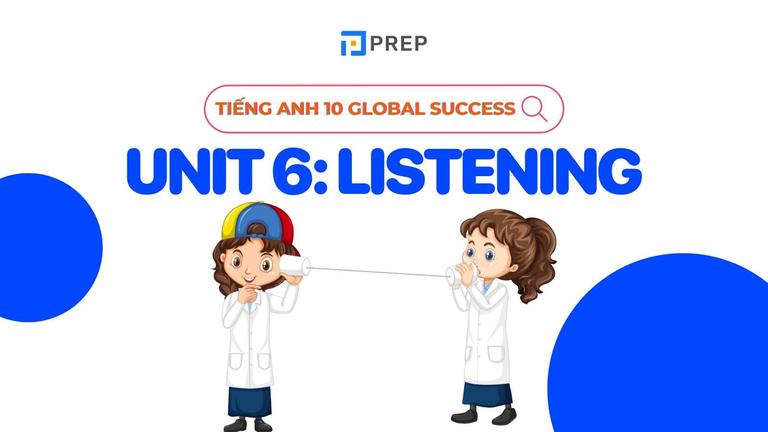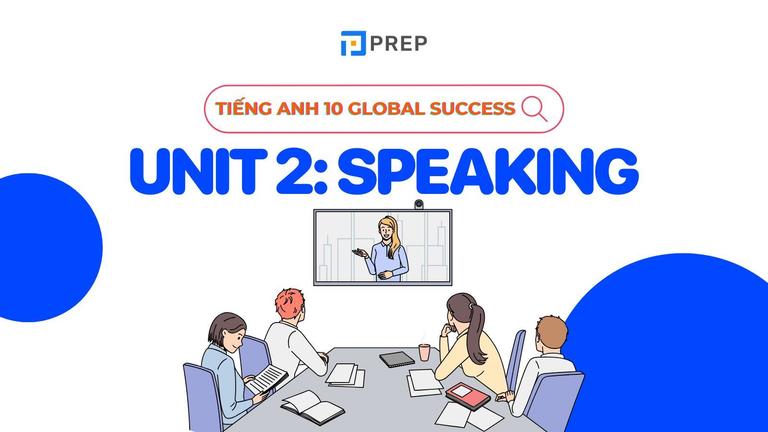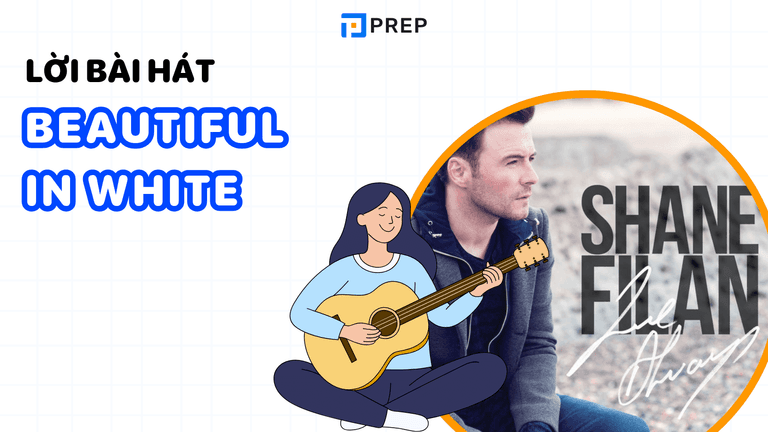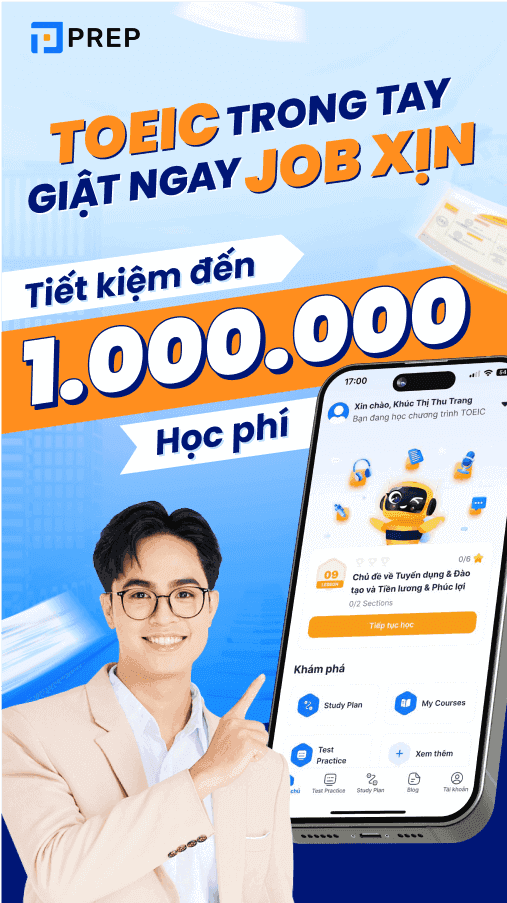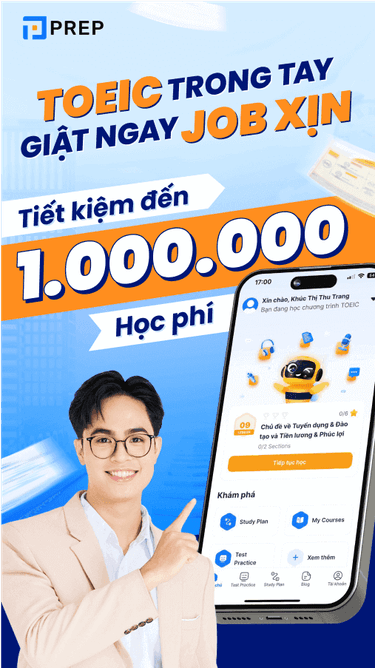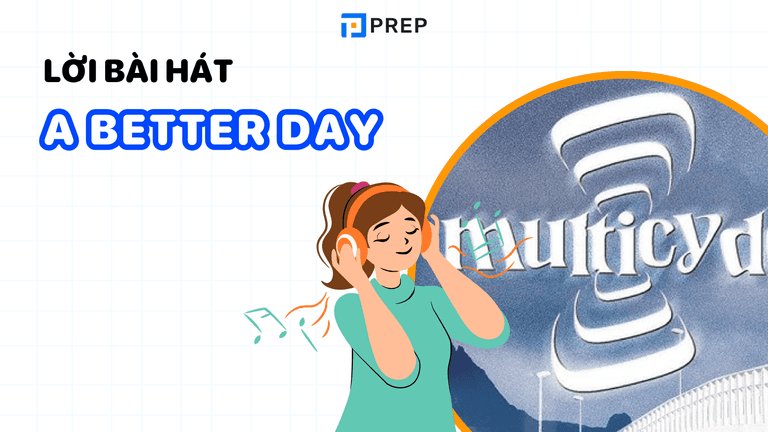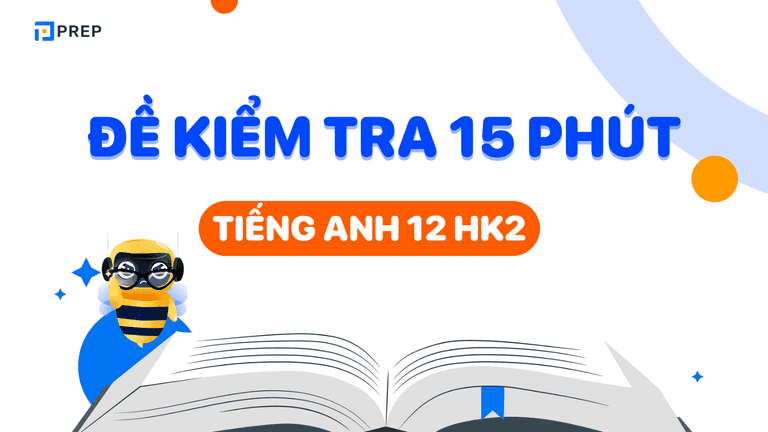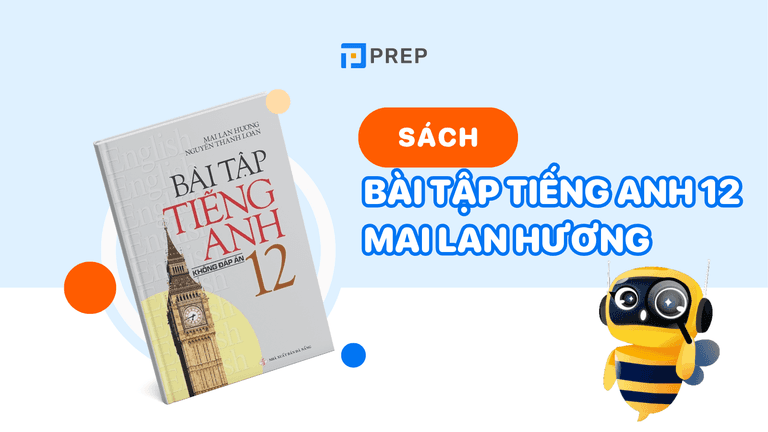Tổng hợp 50+ đề thi tiếng Anh lớp 11 học kỳ I, II có đáp án chi tiết
Bạn đang tìm kiếm các đề thi tiếng Anh lớp 11 chất lượng, bám sát chương trình học và giúp ôn luyện hiệu quả cho các kỳ thi giữa kỳ, cuối kỳ? Trong bài viết này, PREP sẽ tổng hợp các dạng đề thi tiếng Anh lớp 11 theo chương trình giáo dục phổ thông hiện hành, kèm theo cấu trúc, mẹo làm bài và file đề tải về để bạn dễ dàng luyện tập và đạt điểm cao.

I. Cấu trúc đề thi tiếng Anh lớp 11 theo chương trình mới
Theo chương trình giáo dục phổ thông hiện nay, đề thi tiếng Anh lớp 11 thường bao gồm các phần chính như sau:
|
Phần thi |
Nội dung |
|
Ngữ âm (Phonetics) |
Phân biệt cách phát âm, trọng âm của từ (vowel sounds, consonant sounds) |
|
Câu hỏi trắc nghiệm về thì, câu điều kiện, mệnh đề quan hệ, từ loại,... |
|
|
Chức năng ngôn ngữ |
Lựa chọn đáp án đúng cho các tình huống giao tiếp (functional language) |
|
Đọc hiểu (Reading) |
Bài đọc ngắn với câu hỏi trắc nghiệm hoặc điền từ vào chỗ trống |
|
Viết (Writing) |
Viết câu lại (sentence transformation), viết đoạn văn ngắn hoặc thư/email |
II. Đề tiếng Anh lớp 11 học kỳ I có đáp án chi tiết
Dưới đây là tổng hợp các bộ đề tiếng Anh 11 học kỳ 1 có đáp án chi tiết mà các bạn nên download về để luyện tập.
1. Đề thi tiếng Anh lớp 11 học kì 1
Trước tiên, hãy cùng luyện tập một đề thi tiếng Anh lớp 11 có đáp án học kì 1 để làm quen nhé!
Mark the letter A, B, C, or D on your answer sheet to indicate the word whose underlined part is pronounced differently from the rest.
Question 1. A. helped B. looked C. needed D. watched
Question 2. A. much B. cut C. put D. sun
Mark the letter A, B, C, or D on your answer sheet to indicate the word that has a stress pattern different from the rest.
Question 3. A. support B. listen C. advise D. pursue
Question 4. A. disability B. independent C. understanding D. diameter
Mark the letter A, B, C, or D on your answer sheet to indicate the underlined part that needs correction in each of the following questions.
Question 5. I am looking forward to (A) hear (B) from my pen pal (C) in (D) Australia.
Question 6. My brother (A) behaved (B) very (C) bad at the party last night, which made us (D) ashamed.
Question 7. She (A) has finished her assignment (B) on global warming (C) yesterday evening (D).
Mark the letter A, B, C, or D on your answer sheet to indicate the most suitable response to complete each of the following exchanges.
Question 8. Nam: “How about going to the cinema tonight?” - Lan: “___________”
A. I don’t think so.
B. That sounds like a great idea.
C. Good luck!
D. You’re welcome.
Question 9. Customer: "Thank you for your excellent service." - Waiter: "___________"
A. No, thanks.
B. It’s my pleasure, sir.
C. Yes, please.
D. Don't say that.
Mark the letter A, B, C, or D on your answer sheet to indicate the word(s) SIMILAR in meaning to the underlined word(s) in each of the following questions.
Question 10. They donated a large sum of money to the charity to help disadvantaged children.
A. borrowed
B. spent
C. raised
D. gave
Question 11. He is a very talented musician who can play five different instruments.
A. famous
B. gifted
C. professional
D. hard-working
Mark the letter A, B, C, or D on your answer sheet to indicate the word(s) OPPOSITE in meaning to the underlined word(s) in each of the following questions.
Question 12. My parents are very generous people; they are always willing to help others.
A. kind
B. mean
C. caring
D. helpful
Question 13. A reliable friend is someone you can always count on for support.
A. loyal
B. honest
C. untrustworthy
D. sensitive
Mark the letter A, B, C, or D on your answer sheet to indicate the sentence that is closest in meaning to each of the following questions.
Question 14. "I'm sorry I broke the vase," said Tom.
A. Tom denied breaking the vase.
B. Tom admitted breaking the vase.
C. Tom refused to break the vase.
D. Tom apologized for breaking the vase.
Question 15. It isn't necessary for you to finish the work today.
A. You can't finish the work today.
B. You must finish the work today.
C. You don't have to finish the work today.
D. You should finish the work today.
Question 16. He didn't study hard, so he failed the final exam.
A. If he had studied hard, he wouldn't have failed the final exam.
B. If he studied hard, he wouldn't fail the final exam.
C. If he studied harder, he would have passed the final exam.
D. Unless he studied hard, he would have failed the final exam.
Mark the letter A, B, C, or D on your answer sheet to indicate the sentence that best combines each pair of sentences in the following questions.
Question 17. The man is my new English teacher. He is talking to the principal.
A. The man who is talking to the principal is my new English teacher.
B. The man is my new English teacher, so he is talking to the principal.
C. The man whom is talking to the principal is my new English teacher.
D. The man is my new English teacher who he is talking to the principal.
Question 18. The weather was very bad. We decided to cancel our camping trip.
A. Despite the bad weather, we decided to cancel our camping trip.
B. Because the weather was very bad, we decided to cancel our camping trip.
C. The weather was too bad for us to not cancel our camping trip.
D. We decided to cancel our camping trip, but the weather was very bad.
Mark the letter A, B, C, or D on your answer sheet to indicate the correct answer to each of the following questions.
Question 19. My best friend and I really ______. We have so many things in common.
A. get on well with each other
B. break up with each other
C. fall out with each other
D. look down on each other
Question 20. It’s important for young people to develop a sense of ______ before they leave home.
A. independent
B. depend
C. independence
D. independently
Question 21. They volunteered ______ the elderly in the nursing home.
A. to helping
B. helping
C. help
D. to help
Question 22. The woman ______ is sitting next to my mother is my aunt.
A. which
B. who
C. whom
D. whose
Question 23. If I were you, I ______ his apology. He was really sincere.
A. will accept
B. would accept
C. would have accepted
D. accept
Question 24. I felt very ______ when he told me about his family’s situation.
A. sympathy
B. sympathetic
C. sympathize
D. sympathetically
Question 25. They invited all their friends and relatives to their ______ party.
A. house-warming
B. sweet-sixteen
C. graduation
D. birthday
Question 26. The effects of global warming are having a serious impact ______ the environment.
A. with
B. in
C. on
D. for
Question 27. By the time we arrived at the station, the train ______.
A. left
B. has left
C. was leaving
D. had left
Question 28. You ______ me you were coming! I would have cooked something special.
A. must have told
B. could tell
C. should have told
D. had to tell
Question 29. The teacher advised us ______ more time on our pronunciation.
A. to spend
B. spending
C. spend
D. to have spent
Question 30. He decided to ______ a new hobby to make his life more interesting.
A. take up
B. give up
C. look for
D. turn on
Read the following passage and mark the letter A, B, C, or D on your answer sheet to choose the word or phrase that best fits each of the numbered blanks from 31 to 35.
Volunteering can be a deeply rewarding experience. It offers a chance to give back to the community and (31)______ a real difference in people's lives. There are countless opportunities available, from working with children at a local school to helping at an animal shelter. (32), finding the right opportunity that fits your skills and interests is key to a fulfilling experience.
Many people (33) choose to volunteer are motivated by a desire to help others. They find great satisfaction in knowing their efforts contribute to a greater good. For students, volunteering can also be a valuable way to gain practical experience and develop new skills. It is an opportunity to learn teamwork, communication, and problem-solving, all (34)______ are highly valued by employers. Ultimately, the act of giving one’s time and energy without expecting payment is one of the most selfless things a person can do, bringing benefits not just to the recipients but also to the volunteer’s own sense (35)______ purpose and happiness.
Question 31. A. do B. make C. have D. cause
Question 32. A. However B. Therefore C. For example D. In addition
Question 33. A. whom B. which C. who D. whose
Question 34. A. of which B. that C. what D. which
Question 35. A. for B. with C. of D. on
Read the following passage and mark the letter A, B, C, or D on your answer sheet to indicate the correct answer to each of the questions from 36 to 42.
Global warming is the long-term heating of Earth’s climate system observed since the pre-industrial period (between 1850 and 1900) due to human activities, primarily fossil fuel burning, which increases heat-trapping greenhouse gas levels in Earth's atmosphere. The term is frequently used interchangeably with the term climate change, though the latter refers to both human- and naturally produced warming and the effects it has on our planet.
The main cause of global warming is the "greenhouse effect." Some gases in the Earth's atmosphere act a bit like the glass in a greenhouse, trapping the sun's heat and stopping it from leaking back into space. Many of these gases occur naturally, but human activity is increasing the concentrations of some of them in the atmosphere, particularly carbon dioxide (CO2), methane, and nitrous oxide. These human-produced emissions have primarily been driven by the burning of fossil fuels for energy, deforestation, and industrial processes.
The consequences of global warming are far-reaching and affect many aspects of the natural world and human society. These include more frequent and intense heatwaves, rising sea levels due to melting glaciers and ice sheets, and changes in precipitation patterns that can lead to both droughts and floods. Ecosystems are also under threat, with many species of plants and animals facing extinction as their habitats change faster than they can adapt. Addressing this global challenge requires a concerted effort from all nations to reduce greenhouse gas emissions and transition to sustainable energy sources.
Question 36. What is the main topic of the passage?
A. The history of climate change studies.
B. The causes and effects of global warming.
C. The differences between global warming and climate change.
D. The solutions to reduce greenhouse gas emissions.
Question 37. According to the passage, what is the primary driver of increased greenhouse gases?
A. Natural volcanic eruptions
B. Changes in the Earth's orbit
C. Human activities like burning fossil fuels
D. The natural greenhouse effect
Question 38. The word “it” in paragraph 2 refers to ______.
A. the Earth's atmosphere
B. the sun's heat
C. a greenhouse
D. human activity
Question 39. Which of the following is NOT mentioned as a consequence of global warming?
A. More intense heatwaves
B. Rising sea levels
C. A decrease in droughts
D. Threats to ecosystems
Question 40. The phrase "concerted effort" in the last paragraph is closest in meaning to ______.
A. a separate attempt
B. a musical performance
C. a simple action
D. a joint action
Question 41. What can be inferred from the passage?
A. Global warming is a natural phenomenon that humans cannot control.
B. Only industrialized countries are responsible for global warming.
C. Global warming is a serious issue that requires international cooperation.
D. The effects of global warming are limited to the polar regions.
Question 42. The term "climate change" is different from "global warming" because it ______.
A. only refers to natural warming
B. is a less serious issue
C. includes both human-caused and natural warming
D. was discovered more recently
--- THE END ---
ĐÁP ÁN VÀ GIẢI THÍCH CHI TIẾT:
|
Câu |
Đáp án |
Giải thích chi tiết |
|
1 |
C |
Phát âm đuôi -ed: needed phát âm là /ɪd/ vì tận cùng là /d/. Các từ còn lại (helped, looked, watched) phát âm là /t/ vì tận cùng là các âm vô thanh /p/, /k/, /tʃ/. |
|
2 |
C |
Nguyên âm: put phát âm là /pʊt/. Các từ còn lại (much, cut, sun) có nguyên âm /ʌ/. |
|
3 |
B |
Trọng âm: listen có trọng âm ở âm tiết thứ nhất. Các động từ còn lại (support, advise, pursue) có trọng âm ở âm tiết thứ hai. |
|
4 |
D |
Trọng âm: diameter /daɪˈæmɪtər/ có trọng âm ở âm tiết thứ 2. Các từ còn lại (independent, understanding, volunteer) có trọng âm ở âm tiết thứ 3. |
|
5 |
B |
Lỗi sai: hear -> hearing. Cấu trúc "look forward to + V-ing": mong chờ làm gì. |
|
6 |
C |
Lỗi sai: bad -> badly. Cần một trạng từ để bổ nghĩa cho động từ behaved. |
|
7 |
A |
Lỗi sai: has finished -> finished. Thì Hiện tại hoàn thành không dùng với trạng từ chỉ thời gian quá khứ cụ thể như yesterday. Phải dùng thì Quá khứ đơn. |
|
8 |
B |
Giao tiếp: Nam đưa ra lời gợi ý ("Hay là tối nay đi xem phim đi?"). Lan đồng ý với ý kiến đó ("Nghe có vẻ là một ý tưởng tuyệt vời"). |
|
9 |
B |
Giao tiếp: Khách hàng cảm ơn vì dịch vụ tuyệt vời. Người phục vụ đáp lại một cách lịch sự ("Đó là niềm vinh hạnh của tôi, thưa ngài"). |
|
10 |
D |
Từ đồng nghĩa: donated (quyên góp) = gave (cho, tặng). |
|
11 |
B |
Từ đồng nghĩa: talented (tài năng) = gifted (có năng khiếu, tài năng). |
|
12 |
B |
Từ trái nghĩa: generous (hào phóng) >< mean (keo kiệt, bủn xỉn). |
|
13 |
C |
Từ trái nghĩa: reliable (đáng tin cậy) >< untrustworthy (không đáng tin cậy). |
|
14 |
D |
Câu đồng nghĩa: "I'm sorry..." là cấu trúc để xin lỗi. "Tom apologized for breaking the vase" (Tom đã xin lỗi vì làm vỡ chiếc bình). |
|
15 |
C |
Câu đồng nghĩa: "It isn't necessary for you..." (Bạn không cần thiết phải...) = "You don't have to..." (Bạn không cần phải...). |
|
16 |
A |
Câu đồng nghĩa: Đây là câu điều kiện loại 3, diễn tả một điều trái với quá khứ. "If he had studied hard, he wouldn't have failed..." (Nếu anh ấy học chăm, anh ấy đã không trượt...). |
|
17 |
A |
Kết hợp câu: Dùng mệnh đề quan hệ chỉ người who để kết hợp hai câu. "The man who is talking to the principal..." (Người đàn ông mà đang nói chuyện với hiệu trưởng...). |
|
18 |
B |
Kết hợp câu: Dùng liên từ chỉ nguyên nhân Because để nối hai câu có quan hệ nhân - quả. "Bởi vì thời tiết xấu, chúng tôi đã hủy chuyến đi." |
|
19 |
A |
Cụm động từ: get on well with each other: có mối quan hệ tốt với nhau, hòa thuận. |
|
20 |
C |
Từ loại: Sau mạo từ "a" và danh từ "sense" cần một danh từ. independence (sự độc lập). |
|
21 |
D |
Ngữ pháp: Cấu trúc volunteer to do something: tình nguyện làm gì. |
|
22 |
B |
Mệnh đề quan hệ: Dùng đại từ quan hệ who để thay thế cho danh từ chỉ người (the woman) làm chủ ngữ trong mệnh đề quan hệ. |
|
23 |
B |
Câu điều kiện loại 2: Diễn tả một giả định trái với hiện tại (If + S + V2/ed, S + would + V-inf). |
|
24 |
B |
Từ loại: Sau động từ to be (felt) cần một tính từ. sympathetic (thông cảm). |
|
25 |
A |
Từ vựng: house-warming party: tiệc tân gia. |
|
26 |
C |
Giới từ: Cụm từ impact on something: tác động lên cái gì. |
|
27 |
D |
Thì quá khứ hoàn thành: Diễn tả một hành động xảy ra trước một hành động khác trong quá khứ. Hành động tàu rời đi (had left) xảy ra trước hành động chúng tôi đến (arrived). |
|
28 |
C |
Modal verb: should have + V3/ed: lẽ ra nên làm gì (nhưng đã không làm). Thể hiện sự trách móc nhẹ nhàng. |
|
29 |
A |
Ngữ pháp: Cấu trúc advise somebody to do something: khuyên ai làm gì. |
|
30 |
A |
Cụm động từ: take up a hobby: bắt đầu một sở thích mới. |
|
31 |
B |
Cụm từ: make a difference: tạo ra sự khác biệt. |
|
32 |
A |
Liên từ: However (Tuy nhiên) được dùng để giới thiệu một ý tương phản (có nhiều cơ hội, tuy nhiên, việc tìm đúng cơ hội là quan trọng). |
|
33 |
C |
Mệnh đề quan hệ: Dùng who để thay thế cho danh từ chỉ người (Many people). |
|
34 |
D |
Mệnh đề quan hệ: Dùng which để thay thế cho cả một danh sách các kỹ năng được liệt kê trước đó (teamwork, communication, and problem-solving). |
|
35 |
C |
Cụm từ: sense of purpose: ý thức về mục đích sống. |
|
36 |
B |
Main idea: Đoạn văn trình bày định nghĩa, nguyên nhân chính (hiệu ứng nhà kính, hoạt động của con người) và hậu quả (nắng nóng, nước biển dâng,...) của nóng lên toàn cầu. |
|
37 |
C |
Detail: Đoạn 1 và 2 đều nhấn mạnh "due to human activities, primarily fossil fuel burning". |
|
38 |
B |
Reference: "...trapping the sun's heat and stopping it from leaking back into space." -> "it" ở đây chính là "the sun's heat" (nhiệt của mặt trời). |
|
39 |
C |
Detail: Đoạn 3 liệt kê "droughts and floods" là hậu quả, chứ không phải "a decrease in droughts" (sự giảm hạn hán). |
|
40 |
D |
Vocabulary: "concerted effort" (nỗ lực chung, phối hợp) gần nghĩa nhất với "a joint action" (một hành động chung). |
|
41 |
C |
Inference: Câu cuối "Addressing this global challenge requires a concerted effort from all nations" cho thấy đây là một vấn đề nghiêm trọng cần sự hợp tác quốc tế. |
|
42 |
C |
Detail: Đoạn 1 "...the latter refers to both human- and naturally produced warming...". "the latter" ở đây là "climate change". |
2. Download đề kiểm tra tiếng Anh 11 học kì 1
PREP sưu tầm và tổng hợp đề thi tiếng anh lớp 11 học kì 1 có đáp án sau đây, các bạn hãy dành thời gian download và luyện tập hiệu quả để chuẩn bị cho kỳ thi cuối kì 1 nhé!

III. Đề thi lớp 11 môn tiếng anh học kì 2
1. Đề thi thử tiếng Anh lớp 11 học kì 2
Trước tiên, hãy cùng luyện đề tiếng anh lớp 11 học kì 2 nhé!
Mark the letter A, B, C, or D on your answer sheet to indicate the word whose underlined part differs from that of the other three in pronunciation in each of the following questions.
Question 1. A. polluted B. provided C. damaged D. needed
Question 2. A. source B. course C. resource D. tourism
Mark the letter A, B, C, or D on your answer sheet to indicate the word that differs from the rest in the position of the main stress in each of the following questions.
Question 3. A. technology B. environment C. infrastructure D. sustainable
Question 4. A. conserve B. affect C. threaten D. pollute
Mark the letter A, B, C, or D on your answer sheet to indicate the correct answer to each of the following questions.
Question 5. ________ is a serious problem that requires global cooperation to solve.
A. Deforestation B. Afforestation C. Reforestation D. Conservation
Question 6. For a city to be 'smart', the first thing ________ is its infrastructure.
A. improving B. to improve C. improved D. to improving
Question 7. After ________ from university, she decided to work for a non-governmental organization.
A. graduate B. graduating C. to graduate D. graduated
Question 8. It was in this small town ________ my grandparents spent their childhood.
A. which B. who C. that D. where
Question 9. We should ________ on renewable energy sources like solar and wind power.
A. give up B. rely on C. look after D. take off
Question 10. My parents were very proud of my sister ________ a scholarship to study abroad.
A. winning B. to win C. won D. to winning
Question 11. It was her innovative idea ________ saved the company from bankruptcy.
A. that B. which C. who D. when
Question 12. My teacher always advises us to avoid ________ single-use plastic products.
A. use B. to use C. using D. used
Question 13. Many people have a negative attitude ________ new technologies, fearing they might lose their jobs.
A. towards B. with C. for D. on
Question 14. ________ can lead to many health problems, including stress and lack of sleep.
A. Cybercrime B. Social media C. Overworking D. Healthy diet
Question 15. In urban areas, we often use public ________ such as buses and subways to get around.
A. transport B. traffic C. vehicle D. communication
Question 16. An ________ lifestyle is crucial to protect the environment for future generations.
A. eco-friendly B. economically C. economical D. ecology
Read the following school announcement and mark the letter A, B, C, or D on your answer sheet to indicate the correct option that best fits each of the numbered blanks.
Announcement: Green School Initiative
Our school is excited to announce the launch of the "Green School Initiative". The goal of this program is to raise awareness about environmental issues among students.
The campaign will officially start (17)______ Monday, April 22nd, which is also Earth Day. We encourage all students (18)______ in the various activities planned.
These activities will include tree planting, a recycling competition, and workshops on sustainable living. The full list of (19)______ and their schedules will be posted on the school's website. We believe that with everyone's effort, we can make our school a greener place.
Question 17. A. at B. in C. on D. from
Question 18. A. to participate B. participating C. participate D. participated
Question 19. A. activists B. actions C. activities D. actors
Mark the letter A, B, C, or D on your answer sheet to indicate the correct arrangement of the sentences to make a meaningful paragraph/letter in each of the following questions.
Question 20.
a. Secondly, we need to promote the use of renewable energy sources.
b. To achieve this, several important steps must be taken.
c. In conclusion, by combining these efforts, we can build a sustainable future.
d. Firstly, raising public awareness about the consequences of climate change is essential.
e. The goal is to reduce our carbon footprint and combat global warming.
A. e-b-d-a-c
B. b-e-a-d-c
C. e-d-a-b-c
D. d-a-c-b-e
Question 21.
a. I am writing to apply for the volunteer position advertised on your website.
b. I have experience working with children and am passionate about environmental education.
c. I look forward to hearing from you soon.
d. Dear Mr. Smith,
e. I am confident that my skills and enthusiasm would make me a great addition to your team.
A. d-b-a-e-c
B. d-a-b-e-c
C. a-d-b-e-c
D. d-a-e-b-c
Read the following passage and mark the letter A, B, C, or D on your answer sheet to indicate the correct word or phrase that best fits each of the numbered blanks from 22 to 26.
Ecotourism is a form of tourism that appeals to ecologically and socially conscious individuals. It focuses on volunteering, personal growth, and learning new ways to live on the planet. It typically involves travel to destinations (22)______ flora, fauna, and cultural heritage are the primary attractions.
The goal of ecotourism is to have a low impact on the local environment and to respect the local culture. It also aims to provide financial benefits and empowerment for local people. (23), a key principle of ecotourism is that it should contribute to conservation efforts. Tourists are encouraged to actively participate in protecting the environment, (24) by joining a beach clean-up or donating to a local conservation project.
While ecotourism is becoming increasingly popular, it's important for travelers to do their research to ensure that the tour operators they choose are genuinely committed to these principles. A truly ecotourist experience should be one that benefits (25)______ the traveler and the host community, while minimizing negative impacts on the environment. It is a responsible way of traveling (26)______ helps preserve the natural wonders of our world for generations to come.
Question 22. A. where B. which C. who D. when
Question 23. A. However B. In addition C. Therefore D. For example
Question 24. A. such as B. as well C. instead of D. rather than
Question 25. A. neither B. either C. not only D. both
Question 26. A. who B. which C. what D. whom
Read the following passage and mark the letter A, B, C, or D on your answer sheet to indicate the correct answer to each of the questions from 27 to 33.
Artificial intelligence (AI) is rapidly transforming our world. From self-driving cars to personal assistants on our phones, AI is no longer a concept from science fiction; it is a part of our daily lives. At its core, AI refers to the simulation of human intelligence in machines that are programmed to think like humans and mimic their actions. The term may also be applied to any machine that exhibits traits associated with a human mind such as learning and problem-solving.
One of the most significant impacts of AI is in the field of healthcare. AI algorithms can analyze complex medical data, such as X-rays and scans, to help doctors diagnose diseases like cancer earlier and more accurately. This has the potential to save countless lives. In transportation, AI is the driving force behind the development of autonomous vehicles, which promise to make our roads safer and reduce traffic congestion.
However, the rise of AI also brings significant challenges. A primary concern is job displacement. As AI becomes more capable, many tasks currently performed by humans, from manufacturing to customer service, could be automated. This raises important questions about the future of work and the need for new skills and education. Furthermore, there are ethical concerns about the use of AI, particularly regarding data privacy and the potential for bias in AI algorithms. If AI systems are trained on biased data, they could make unfair decisions that affect people's lives.
Addressing these challenges requires careful planning and regulation. As we continue to develop and integrate AI into our society, it is crucial to ensure that this powerful technology is used responsibly and for the benefit of all humanity.
Question 27. What is the main topic of the passage?
A. The history of artificial intelligence.
B. The benefits and challenges of artificial intelligence.
C. The negative impact of AI on the job market.
D. The use of AI in the healthcare industry.
Question 28. According to the passage, AI can help doctors to ______.
A. perform complex surgeries
B. create new medicines
C. talk to patients in different languages
D. identify diseases more accurately
Question 29. The word "they" in paragraph 3 refers to ______.
A. AI systems B. ethical concerns C. human beings D. biased data
Question 30. Which of the following is NOT mentioned as a challenge of AI?
A. The potential for job losses.
B. The high cost of AI technology.
C. The risk of biased decision-making.
D. The issue of data privacy.
Question 31. The word "autonomous" in paragraph 2 is closest in meaning to ______.
A. self-driving B. expensive C. fast D. electric
Question 32. What can be inferred from the passage?
A. AI will soon replace all human jobs.
B. The development of AI should be stopped.
C. AI is a powerful tool that needs to be managed carefully.
D. Only wealthy countries can benefit from AI.
Question 33. The author's attitude towards AI in the passage is ______.
A. completely negative B. neutral and informative C. purely optimistic D. skeptical
Mark the letter A, B, C, or D to indicate the sentence that best combines each pair of sentences in the following questions.
Question 34. The city has invested in a smart traffic system. The aim is to reduce congestion.
A. The city has invested in a smart traffic system so that it reduced congestion.
B. The city has invested in a smart traffic system in order to reduce congestion.
C. Despite investing in a smart traffic system, the city wants to reduce congestion.
D. The city has invested in a smart traffic system, but it wants to reduce congestion.
Question 35. She works hard. She wants to be a role model for her children.
A. She works hard, for she wants to be a role model for her children.
B. She works hard, therefore she wants to be a role model for her children.
C. She works hard; however, she wants to be a role model for her children.
D. She works hard so that she will be a role model for her children.
Question 36. The local government passed a new law. The law is intended to protect endangered species.
A. The local government passed a new law who is intended to protect endangered species.
B. The local government passed a new law, which is intended to protect endangered species.
C. It was the new law that the local government intended to protect endangered species.
D. The local government passed a new law, so it protected endangered species.
Question 37. He made a great effort to improve his skills. He finally became the best player on the team.
A. After making a great effort to improve his skills, he finally became the best player on the team.
B. It was the best player that made a great effort to improve his skills.
C. He made a great effort to improve his skills; therefore, he became the best player.
D. Although he made a great effort, he became the best player on the team.
Question 38. First, he considered all the options. Then he made a final decision.
A. Having considered all the options, he made a final decision.
B. He made a final decision that considered all the options.
C. He made a final decision before he had considered all the options.
D. It was after he made a final decision that he considered all the options.
Question 39. Many people moved to the city. They were looking for better job opportunities.
A. It was better job opportunities that many people moved to the city.
B. Looking for better job opportunities, many people moved to the city.
C. Many people moved to the city, but they were looking for better job opportunities.
D. Many people moved to the city, so they were looking for better job opportunities.
Question 40. He suggested that we should go on a picnic. He then offered to prepare the food.
A. He suggested going on a picnic; however, he offered to prepare the food.
B. After suggesting that we should go on a picnic, he offered to prepare the food.
C. He offered to prepare the food when he suggested going on a picnic.
D. He suggested that we should go on a picnic, so he offered to prepare the food.
--- THE END ---
ĐÁP ÁN VÀ GIẢI THÍCH CHI TIẾT:
|
Câu |
Đáp án |
Giải thích chi tiết |
|
1 |
C |
Phát âm đuôi -ed: damaged có âm cuối là /dʒ/, là một âm hữu thanh, nên đuôi -ed được phát âm là /d/. Các từ còn lại (polluted, provided, needed) có âm cuối là /t/ hoặc /d/, nên đuôi -ed được phát âm là /ɪd/. |
|
2 |
D |
Phát âm nguyên âm: tourism có phần gạch chân được phát âm là /ʊə/ (/ˈtʊərɪzəm/). Các từ còn lại (source, course, resource) có phần gạch chân được phát âm là /ɔː/. |
|
3 |
C |
Trọng âm: infrastructure /'ɪnfrəstrʌktʃər/ có trọng âm rơi vào âm tiết thứ nhất. Các từ còn lại có trọng âm rơi vào âm tiết thứ hai: technology /tek'nɒlədʒi/, environment /ɪn'vaɪrənmənt/, sustainable /sə'steɪnəbl/. |
|
4 |
C |
Trọng âm: threaten có trọng âm rơi vào âm tiết thứ nhất. Các từ còn lại là động từ 2 âm tiết, có trọng âm rơi vào âm tiết thứ hai: conserve /kən'sɜːv/, affect /əˈfekt/, pollute /pə'luːt/. |
|
5 |
A |
Từ vựng: Deforestation (nạn phá rừng) là một vấn đề nghiêm trọng. Các phương án khác không phù hợp: B, C (trồng lại rừng), D (bảo tồn). |
|
6 |
B |
Ngữ pháp: Dùng động từ nguyên mẫu có 'to' (to-infinitive) để chỉ mục đích hoặc điều cần làm tiếp theo. Cấu trúc: "The first thing to do is..." |
|
7 |
B |
Ngữ pháp: Sau giới từ After, động từ phải ở dạng V-ing (graduating). |
|
8 |
C |
Cấu trúc câu chẻ (Cleft sentence): Cấu trúc "It was + [thành phần nhấn mạnh] + that..." được dùng để nhấn mạnh một thành phần trong câu (ở đây là cụm từ chỉ nơi chốn in this small town). |
|
9 |
B |
Cụm động từ: rely on (dựa vào, phụ thuộc vào). Các phương án khác: A (từ bỏ), C (chăm sóc), D (cất cánh). |
|
10 |
A |
Ngữ pháp: Sau cấu trúc "be proud of + somebody", nếu có hành động đi kèm thì dùng dạng V-ing (winning). "Tự hào về ai đó vì đã làm gì". |
|
11 |
A |
Cấu trúc câu chẻ (Cleft sentence): Tương tự câu 8, cấu trúc "It was + [chủ ngữ] + that + V..." dùng để nhấn mạnh chủ ngữ (her innovative idea). |
|
12 |
C |
Ngữ pháp: Sau động từ avoid (tránh), động từ theo sau phải ở dạng V-ing (using). |
|
13 |
A |
Giới từ: Attitude towards something có nghĩa là "thái độ đối với cái gì đó". |
|
14 |
C |
Từ vựng: Overworking (làm việc quá sức) có thể dẫn đến các vấn đề sức khỏe như stress. Các phương án khác không hợp lý trong ngữ cảnh này. |
|
15 |
A |
Từ vựng: Public transport (giao thông công cộng) là cụm từ cố định chỉ các phương tiện như xe buýt, tàu điện ngầm. |
|
16 |
A |
Từ vựng: Cần một tính từ đứng trước danh từ lifestyle. eco-friendly (thân thiện với môi trường) là phù hợp nhất. |
|
17 |
C |
Giới từ: Dùng giới từ on trước ngày trong tuần (Monday) và ngày tháng cụ thể (April 22nd). |
|
18 |
A |
Ngữ pháp: Cấu trúc encourage somebody to do something (khuyến khích ai làm gì). |
|
19 |
C |
Từ vựng: Activities (các hoạt động) là từ phù hợp nhất để chỉ các sự kiện như trồng cây, thi tái chế. |
|
20 |
A |
Sắp xếp đoạn văn: e là câu chủ đề nêu mục tiêu -> b dẫn dắt vào các bước cần làm -> d (Firstly) là bước đầu tiên -> a (Secondly) là bước thứ hai -> c (In conclusion) là câu kết luận. |
|
21 |
B |
Sắp xếp lá thư: d (Lời chào) -> a (Nêu lý do viết thư) -> b (Cung cấp thông tin, kinh nghiệm) -> e (Bày tỏ sự tự tin) -> c (Lời chào kết). |
|
22 |
A |
Mệnh đề quan hệ: Dùng where để thay thế cho danh từ chỉ nơi chốn (destinations) khi nó đóng vai trò trạng ngữ trong mệnh đề quan hệ. |
|
23 |
B |
Liên từ: In addition (Thêm vào đó) dùng để bổ sung thêm một ý, một nguyên tắc nữa của du lịch sinh thái. |
|
24 |
A |
Cụm từ: such as (ví dụ như) dùng để đưa ra ví dụ minh họa cho hành động "tham gia bảo vệ môi trường". |
|
25 |
D |
Cấu trúc: both ... and ... (cả ... và ...). Câu này có nghĩa là trải nghiệm du lịch sinh thái mang lại lợi ích cho cả du khách và cộng đồng địa phương. |
|
26 |
B |
Mệnh đề quan hệ: Dùng which để thay thế cho danh từ chỉ vật (a responsible way of traveling). that cũng có thể dùng nhưng không có trong phương án. |
|
27 |
B |
Ý chính: Bài đọc trình bày cả mặt tích cực (ứng dụng trong y tế, giao thông) và các thách thức (mất việc làm, vấn đề đạo đức) của AI. |
|
28 |
D |
Chi tiết: Đoạn 2 có câu: "...help doctors diagnose diseases like cancer earlier and more accurately." (giúp bác sĩ chẩn đoán bệnh sớm hơn và chính xác hơn). |
|
29 |
A |
Tham chiếu: Từ they thay thế cho danh từ số nhiều đã được nhắc đến trước đó, đó là AI systems (các hệ thống AI). |
|
30 |
B |
Chi tiết: Bài đọc đề cập đến mất việc làm (job displacement), vấn đề đạo đức/thiên vị (bias), và quyền riêng tư dữ liệu (data privacy) nhưng không đề cập đến The high cost (chi phí cao). |
|
31 |
A |
Từ vựng: autonomous vehicles (phương tiện tự hành) đồng nghĩa với self-driving (tự lái). |
|
32 |
C |
Suy luận: Câu cuối bài "it is crucial to ensure that this powerful technology is used responsibly" cho thấy AI là một công cụ mạnh mẽ và cần được quản lý, sử dụng một cách cẩn trọng. |
|
33 |
B |
Thái độ tác giả: Tác giả trình bày cả mặt lợi và mặt hại của AI một cách khách quan, cung cấp thông tin mà không thể hiện quan điểm quá tiêu cực hay quá lạc quan. Đây là thái độ neutral and informative (trung lập và cung cấp thông tin). |
|
34 |
B |
Kết hợp câu (Mục đích): Câu thứ hai nêu mục đích của hành động ở câu thứ nhất. Cấu trúc in order to + V-inf (để mà) là phù hợp nhất. |
|
35 |
D |
Kết hợp câu (Mục đích): Dùng so that + S + V để diễn tả mục đích. "Cô ấy làm việc chăm chỉ để cô ấy sẽ là một hình mẫu cho con cái." |
|
36 |
B |
Kết hợp câu (Mệnh đề quan hệ không xác định): Dùng which để bổ sung thông tin cho cả một mệnh đề đứng trước. Dấu phẩy được sử dụng trước which. |
|
37 |
A |
Kết hợp câu (Rút gọn mệnh đề trạng ngữ): Khi hai mệnh đề có cùng chủ ngữ, có thể rút gọn mệnh đề trạng ngữ chỉ thời gian (After he made...) thành dạng Having + V3/ed.... |
|
38 |
A |
Kết hợp câu (Rút gọn mệnh đề trạng ngữ): Tương tự câu 37, hành động "xem xét" xảy ra trước hành động "đưa ra quyết định", nên có thể rút gọn thành dạng Having + V3/ed... (Sau khi đã...). |
|
39 |
B |
Kết hợp câu (Rút gọn mệnh đề đồng chủ ngữ): Khi hai hành động xảy ra đồng thời và có cùng chủ ngữ, có thể rút gọn một mệnh đề về dạng V-ing. "Trong lúc tìm kiếm cơ hội việc làm tốt hơn, nhiều người đã chuyển đến thành phố." |
|
40 |
B |
Kết hợp câu (Rút gọn mệnh đề trạng ngữ): Hành động "gợi ý" xảy ra ngay trước hành động "đề nghị". Có thể dùng After + V-ing... để nối hai câu, thể hiện trình tự thời gian. |
2. Download đề thi tiếng Anh lớp 11 học kì 2
Dưới đây là tổng hợp đề thi tiếng anh học kì 2 lớp 11 có đáp án mà PREP sưu tầm. Các bạn download và luyện đề để chuẩn bị cho kỳ thi cuối kỳ 2 hiệu quả nhé!

IV. Bí quyết luyện đề thi tiếng Anh lớp 11 hiệu quả
Vậy, làm thế nào để có thể luyện đề thi tiếng Anh lớp 11 hiệu quả. Hãy thử các bí quyết ôn thi sau đây nhé!
1. Hãy tạo không gian học yên tĩnh
Không gian học yên tĩnh sẽ tăng khả năng tập trung và hiệu quả học tập. Bạn có thể tự sắp xếp không gian học yên tĩnh cho mình hoặc tìm kiếm không gian bên ngoài như góc thư viện, quán cafe để dành thời gian học và tránh bị nhiễu bởi các yếu tố tác động xung quanh nhé!
2. Lựa chọn nguồn đề thi uy tín
Để việc luyện tập đề hiệu quả, các bạn nên cân nhắc lựa chọn địa chỉ uy tín, chất lượng. Các bạn nên làm các dạng đề bám sát theo format đề thi học kỳ lớp 11 để tăng hiệu quả chinh phục các dạng bài và nâng cao điểm số nhé!
Các bạn có thể luyện đề tiếng Anh lớp 11 trực tiếp trên: Vietjack, download các bộ đề trên web vndoc,… Đồng thời, tham khảo thêm 1 số sách luyện đề uy tín: bài tập tiếng Anh 11 có đáp án, Luyện giải bộ đề kiểm tra định kỳ tiếng Anh 11, Bài tập trắc nghiệm tiếng Anh 11 nâng cao có đáp án,…

3. Nắm vững kiến thức nền tảng
Lớp 11 tiếp học học kiến thức liên quan đến thì quá khứ đơn, thì hiện tại hoàn thành, động từ khuyết thiếu, câu chẻ,... Để có thể luyện tập đề hiệu quả các bạn nên nắm vững các công thức tiếng Anh cơ bản nhất. Từ đó mới có thể dễ dàng vận dụng vào làm các dạng bài tập trong đề thi hiệu quả.
Nếu bạn đang cần tài liệu tổng hợp lại tất tần tật kiến thức ngữ pháp đã học trong chương trình lớp 11 Global Success, đừng bỏ qua “Tổng hợp đầy đủ kiến thức ngữ pháp tiếng Anh lớp 11 Global Success” nhé!

4. Học cách take note hiệu quả
Rèn luyện thói quen take note từ vựng, các công thức khoa học sẽ giúp bạn học tiếng Anh mọi lúc, mọi nơi, hiệu quả hơn rất nhiều. Có rất nhiều phương pháp take note, bạn có thể tham khảo cách take note The Cornell Note để áp dụng nhé!

Tham khảo thêm:
5. Phân tích và nghiên cứu kỹ đáp án
Phần đáp áp sau mỗi đề là học liệu vô cùng bổ ích dành cho bạn. Phân tích và nghiên cứu kỹ đáp án sẽ giúp bạn có thể ghi nhớ những lỗi sai mà mình hay gặp phải, đồng thời ôn lại kiến thức, ghi nhớ cách sử dụng kiến thức vào các dạng bài lâu hơn.
Hãy áp dụng các bí quyết ôn luyện trên không chỉ riêng với đề thi cuối năm lớp 11 môn tiếng Anh mà với cứ kỳ thi nào khác nữa bạn nhé!
Nếu bạn muốn củng cố kiến thức và tìm kiếm thêm nguồn tài liệu, đề thi hữu ích và bám sát chương trình học, đừng bỏ qua:
Tổng hợp bài tập tiếng Anh 11 chuẩn chương trình Global Success
Ôn thi tiếng Anh học kì 1 lớp 11 với đề cương chi tiết và đề ôn thi
Ôn thi tiếng Anh học kì 2 lớp 11 với đề cương chi tiết và đề ôn thi
Trắc nghiệm tiếng anh 11 theo Unit, chuyên đề ngữ pháp và đề kiểm tra
Tổng hợp 20+ đề thi giữa kì 1 tiếng Anh 11 Global Success kèm đáp án chi tiết
Trên đây là tổng hợp 50+ bộ đề thi tiếng Anh lớp 11 và 1 số bí quyết luyện đề hiệu quả mà Prep chia sẻ. Hãy chăm chỉ luyện tập, chắc chắn bạn sẽ đạt được kết quả tốt nhất!"
Học tiếng Anh online dễ dàng hơn với PREP - Nền tảng Học & Luyện thi thông minh cùng AI. Nhờ công nghệ AI độc quyền, bạn có thể tự học trực tuyến ngay tại nhà, chinh phục lộ trình học IELTS, TOEIC, VSTEP, APTIS, tiếng Anh giao tiếp hiệu quả. Bên cạnh đó, học viên còn có sự hỗ trợ tuyệt vời từ Teacher Bee AI, trợ lý ảo giúp bạn giải đáp thắc mắc và đồng hành 1-1 trong suốt quá trình học tập.
Hãy click TẠI ĐÂY hoặc liên hệ HOTLINE 0931428899 để nhận tư vấn chi tiết về các khóa học tiếng Anh chất lượng nhất thị trường!
Tải ngay app PREP để bắt đầu hành trình học tiếng Anh tại nhà với chương trình học luyện thi online chất lượng cao.

Chào bạn! Mình là Hiền Hoàng, hiện đang đảm nhận vai trò quản trị nội dung sản phẩm tại Blog của website prepedu.com.
Với hơn 5 năm tự học các ngoại ngữ như tiếng Anh, tiếng Trung và ôn luyện một số kỳ thi IELTS, TOEIC, HSK, mình đã tự đúc rút được nhiều kinh nghiệm để hỗ trợ hàng nghìn người đang gặp khó khăn trong việc học ngoại ngữ. Hy vọng rằng những chia sẻ phía trên sẽ giúp ích cho bạn trong quá trình tự ôn luyện thi hiệu quả tại nhà!
Bình luận
Nội dung premium
Xem tất cảLộ trình cá nhân hoá
Có thể bạn quan tâm
Kết nối với Prep

MSDN: 0109817671.
Địa chỉ liên hệ: Tòa nhà Vinaconex, 34 Láng Hạ, phường Láng, TP Hà Nội.
Địa chỉ kinh doanh: Lô 21 C2 Khu đô thị Nam Trung Yên, phường Yên Hòa, TP Hà Nội.
Trụ sở: Số nhà 20, ngách 234/35 đường Hoàng Quốc Việt, phường Nghĩa Đô, TP Hà Nội.
Phòng luyện ảo - Trải nghiệm thực tế - Công nghệ hàng đầu.
Hotline: 0931 42 8899.
Trụ sở: Số nhà 20, ngách 234/35 đường Hoàng Quốc Việt, phường Nghĩa Đô, TP Hà Nội.
Giấy chứng nhận hoạt động đào tạo, bồi dưỡng số 1309/QĐ-SGDĐT ngày 31 tháng 07 năm 2023 do Sở Giáo dục và Đào tạo Hà Nội cấp.
